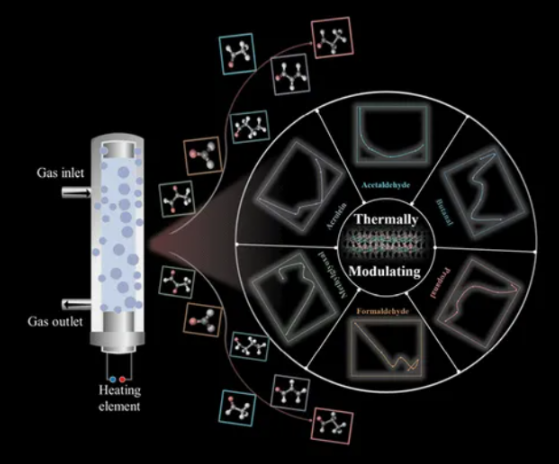The research team led by Lv Yi from Sichuan University has published an important research result in the international journal Analytical Chemistry (Anal. Chem. 2024, 96, 11239-11246). This study successfully developed a high-temperature catalytic luminescence (CTL) sensor system based on gadolinium oxide (Gd2O3). This system can quickly and sensitively detect and distinguish six common aldehyde molecules, providing an innovative and low-cost solution for efficient detection of volatile organic compounds (VOCs), with broad prospects for environmental monitoring and health applications.
一、 Background introduction
Aldehyde molecules are a class of organic compounds containing carbonyl groups (- CHO), widely used in the chemical, pesticide, dye, and materials industries due to their high reactivity, such as in the synthesis of polymers, wood preservatives, and disinfectants. However, excessive emissions of aldehydes pose a serious threat to the environment and health. Formaldehyde is a common indoor pollutant that can cause irritation to the eyes and respiratory tract, and even lead to cancer; Acrolein has strong toxicity and high concentration exposure may be fatal. Long term exposure to aldehydes can lead to chronic diseases and may even induce genetic mutations. In addition, aldehydes are highly volatile and flammable, and may undergo violent reactions when in contact with oxygen. Their detection is crucial for environmental safety and health monitoring.
The existing aldehyde detection technologies such as gas chromatography, fluorescence detection, and electrochemical sensors, although highly sensitive, generally suffer from problems such as expensive equipment, time-consuming detection, and complex operation, especially when distinguishing structurally similar homologous compounds, which have limitations in accuracy. Therefore, developing a fast, convenient, and cost-effective detection technology has become a hot and difficult topic of concern in the current scientific community.

二、 Main research content
The research team has innovatively developed a high-temperature catalytic luminescence sensor system, which uses gadolinium oxide (Gd2O3) as the core sensing material and combines temperature control strategies to achieve efficient detection and accurate differentiation of six common aldehyde molecules, including formaldehyde, acetaldehyde, acetaldehyde, butyraldehyde, methylglyoxal, and acrolein. The team optimized the preparation conditions of gadolinium oxide by hydrothermal method, and the Gd2O3 synthesized at 120 ° C exhibited the best catalytic performance. This material has a large specific surface area and high adsorbed oxygen content, which can effectively enhance the luminescence signal generated during the catalytic oxidation process, achieving a significant improvement in detection sensitivity. The detection limit for formaldehyde is as low as 0.001 μ g/mL.
The developed sensor system captures the CTL response curves of target aldehydes at different temperatures through temperature regulation, and can obtain a unique "constellation map" (Figure 1). This innovative approach combines the thermodynamic and kinetic properties between the target molecule and the sensing material, which not only enables rapid differentiation of structurally similar homologous compounds, but also overcomes the anti-interference problem of traditional techniques in detecting complex gas mixtures. The experiment further verified the performance of the sensor, with a response time of less than 2 seconds and a recovery time of less than 45 seconds. The detection performance remained stable within 30 days. In addition, the system exhibits excellent discriminative ability in the detection of mixed gas samples, such as successfully identifying and quantitatively analyzing a mixture of formaldehyde and acrolein. This system provides strong technical support for fast and highly sensitive multi-component detection.
三、 Conclusion
The isothermal catalytic luminescence sensor system developed in this study has broken through the bottleneck of traditional detection technology. With gadolinium oxide as the core, it achieves efficient detection and accurate differentiation of six aldehyde molecules through a single sensing material and temperature regulation. Sensors have high sensitivity, fast response, and long-term stability, providing new technological support for fields such as environmental monitoring, food safety, and health diagnosis. The research team stated that in the future, they will further expand the constellation map database, develop a wider range of application scenarios, and provide more powerful solutions for the detection of multi-component complex chemical substances.
Source of Information:
https://doi.org/10.1021/acs.analchem.4c0076



